Case Assessment: Soft Drink Industry - Coke and Pepsi
VerifiedAdded on 2022/09/29
|9
|1371
|21
Case Study
AI Summary
This case assessment analyzes the soft drink concentrate industry, focusing on the competition between Coca-Cola and PepsiCo. Using Porter's Five Forces, the analysis examines the bargaining power of buyers and suppliers, the threat of new entrants and substitutes, and the intensity of competitive rivalry. The assessment explores the dominance of the two firms, the impact of their competition on industry profits, and the challenges they face. The analysis highlights their strategies, including extensive promotional activities, R&D investments, and product differentiation. The case also addresses the industry's reliance on Coke and PepsiCo's market share and the potential impact of changing consumer preferences towards non-carbonated beverages and health drinks, suggesting that the companies must innovate to maintain their market position.
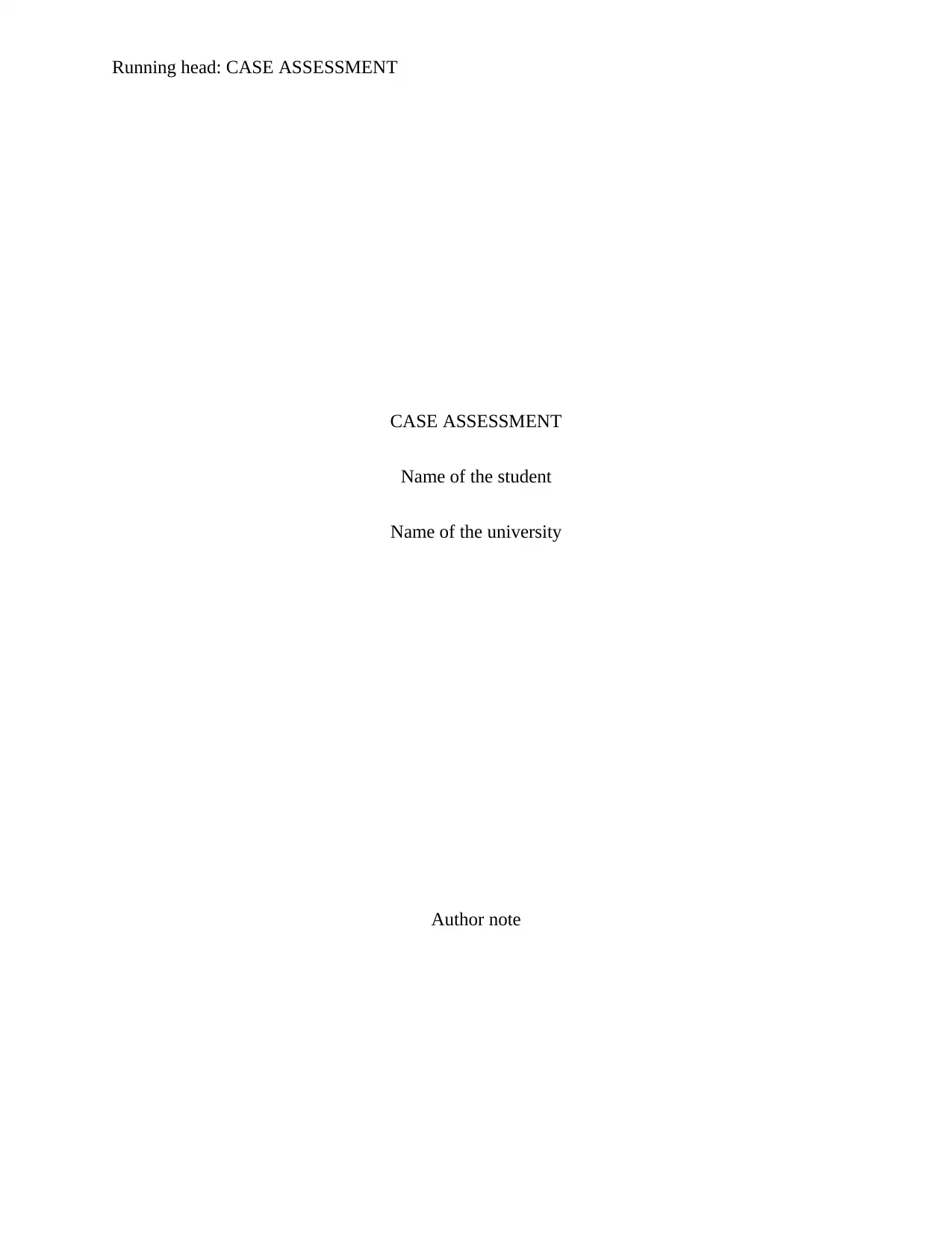
Running head: CASE ASSESSMENT
CASE ASSESSMENT
Name of the student
Name of the university
Author note
CASE ASSESSMENT
Name of the student
Name of the university
Author note
Paraphrase This Document
Need a fresh take? Get an instant paraphrase of this document with our AI Paraphraser
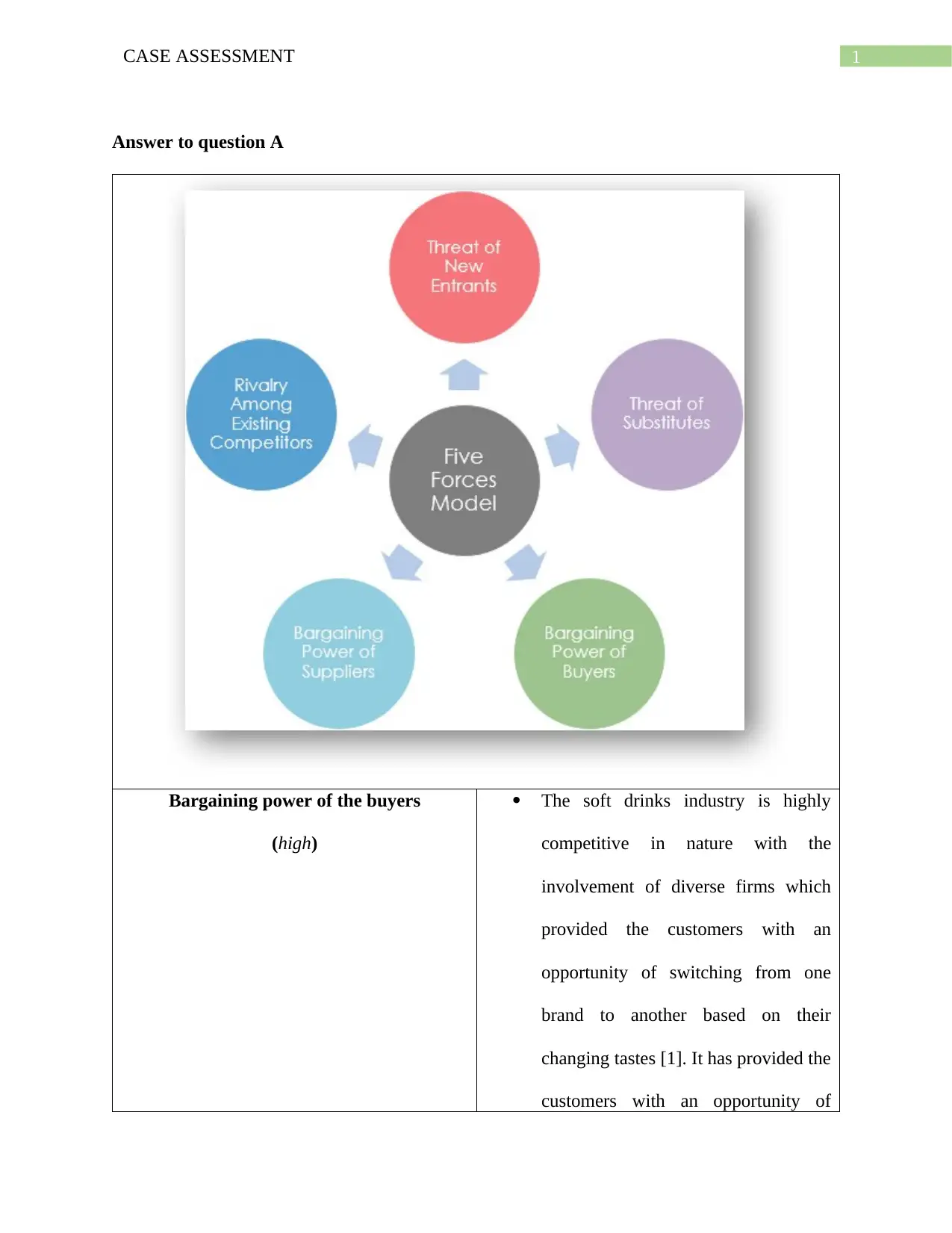
1CASE ASSESSMENT
Answer to question A
Bargaining power of the buyers
(high)
The soft drinks industry is highly
competitive in nature with the
involvement of diverse firms which
provided the customers with an
opportunity of switching from one
brand to another based on their
changing tastes [1]. It has provided the
customers with an opportunity of
Answer to question A
Bargaining power of the buyers
(high)
The soft drinks industry is highly
competitive in nature with the
involvement of diverse firms which
provided the customers with an
opportunity of switching from one
brand to another based on their
changing tastes [1]. It has provided the
customers with an opportunity of
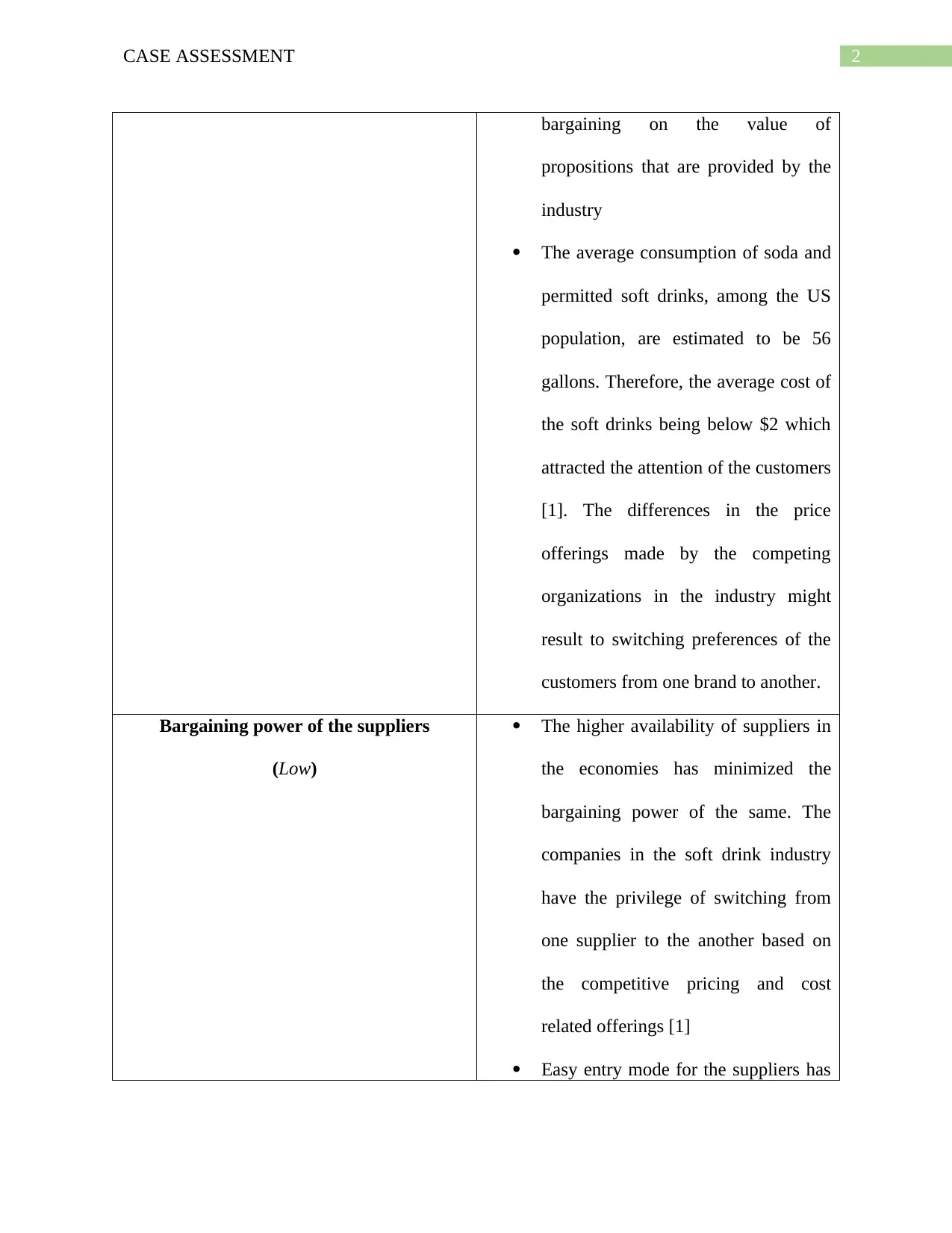
2CASE ASSESSMENT
bargaining on the value of
propositions that are provided by the
industry
The average consumption of soda and
permitted soft drinks, among the US
population, are estimated to be 56
gallons. Therefore, the average cost of
the soft drinks being below $2 which
attracted the attention of the customers
[1]. The differences in the price
offerings made by the competing
organizations in the industry might
result to switching preferences of the
customers from one brand to another.
Bargaining power of the suppliers
(Low)
The higher availability of suppliers in
the economies has minimized the
bargaining power of the same. The
companies in the soft drink industry
have the privilege of switching from
one supplier to the another based on
the competitive pricing and cost
related offerings [1]
Easy entry mode for the suppliers has
bargaining on the value of
propositions that are provided by the
industry
The average consumption of soda and
permitted soft drinks, among the US
population, are estimated to be 56
gallons. Therefore, the average cost of
the soft drinks being below $2 which
attracted the attention of the customers
[1]. The differences in the price
offerings made by the competing
organizations in the industry might
result to switching preferences of the
customers from one brand to another.
Bargaining power of the suppliers
(Low)
The higher availability of suppliers in
the economies has minimized the
bargaining power of the same. The
companies in the soft drink industry
have the privilege of switching from
one supplier to the another based on
the competitive pricing and cost
related offerings [1]
Easy entry mode for the suppliers has
⊘ This is a preview!⊘
Do you want full access?
Subscribe today to unlock all pages.

Trusted by 1+ million students worldwide
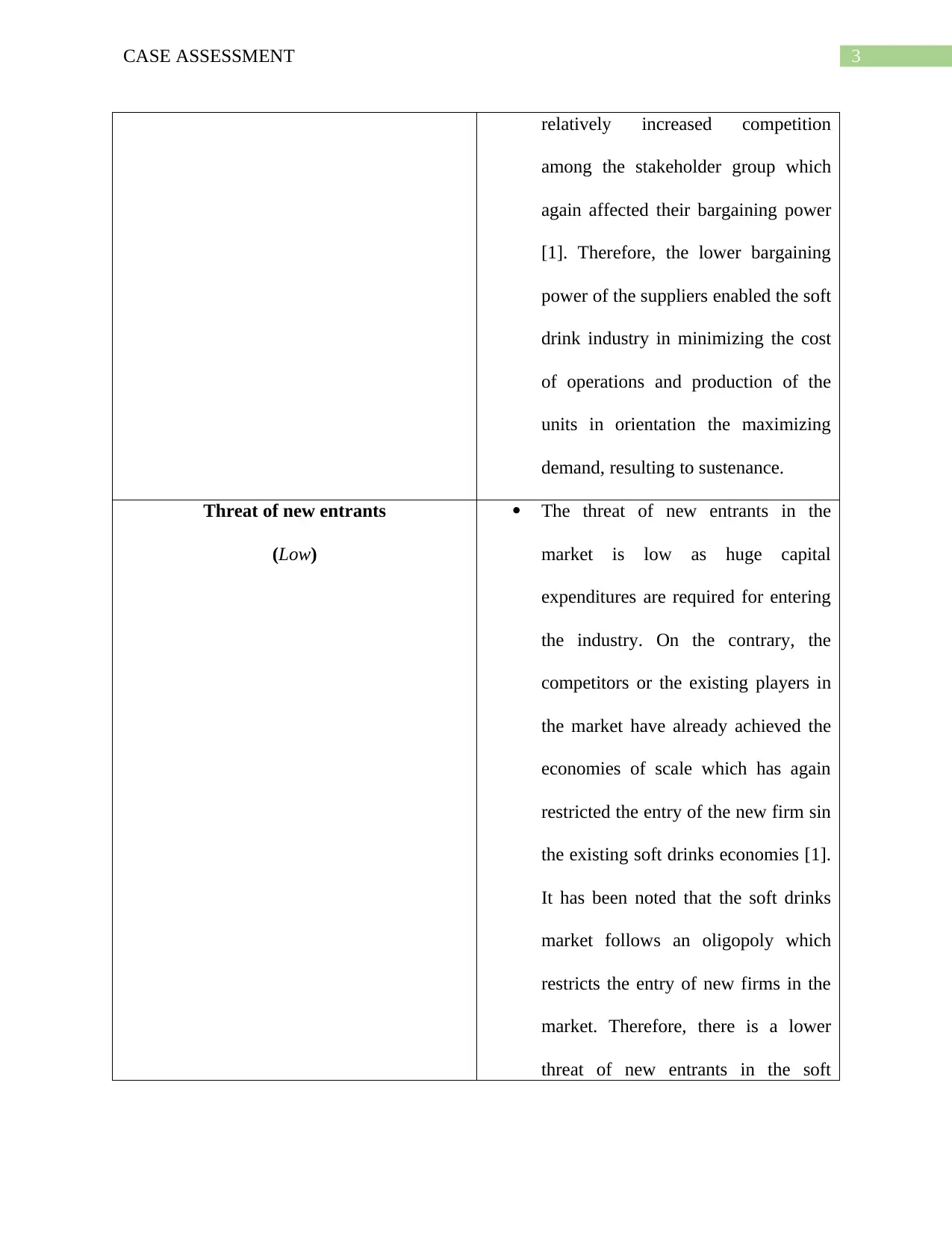
3CASE ASSESSMENT
relatively increased competition
among the stakeholder group which
again affected their bargaining power
[1]. Therefore, the lower bargaining
power of the suppliers enabled the soft
drink industry in minimizing the cost
of operations and production of the
units in orientation the maximizing
demand, resulting to sustenance.
Threat of new entrants
(Low)
The threat of new entrants in the
market is low as huge capital
expenditures are required for entering
the industry. On the contrary, the
competitors or the existing players in
the market have already achieved the
economies of scale which has again
restricted the entry of the new firm sin
the existing soft drinks economies [1].
It has been noted that the soft drinks
market follows an oligopoly which
restricts the entry of new firms in the
market. Therefore, there is a lower
threat of new entrants in the soft
relatively increased competition
among the stakeholder group which
again affected their bargaining power
[1]. Therefore, the lower bargaining
power of the suppliers enabled the soft
drink industry in minimizing the cost
of operations and production of the
units in orientation the maximizing
demand, resulting to sustenance.
Threat of new entrants
(Low)
The threat of new entrants in the
market is low as huge capital
expenditures are required for entering
the industry. On the contrary, the
competitors or the existing players in
the market have already achieved the
economies of scale which has again
restricted the entry of the new firm sin
the existing soft drinks economies [1].
It has been noted that the soft drinks
market follows an oligopoly which
restricts the entry of new firms in the
market. Therefore, there is a lower
threat of new entrants in the soft
Paraphrase This Document
Need a fresh take? Get an instant paraphrase of this document with our AI Paraphraser
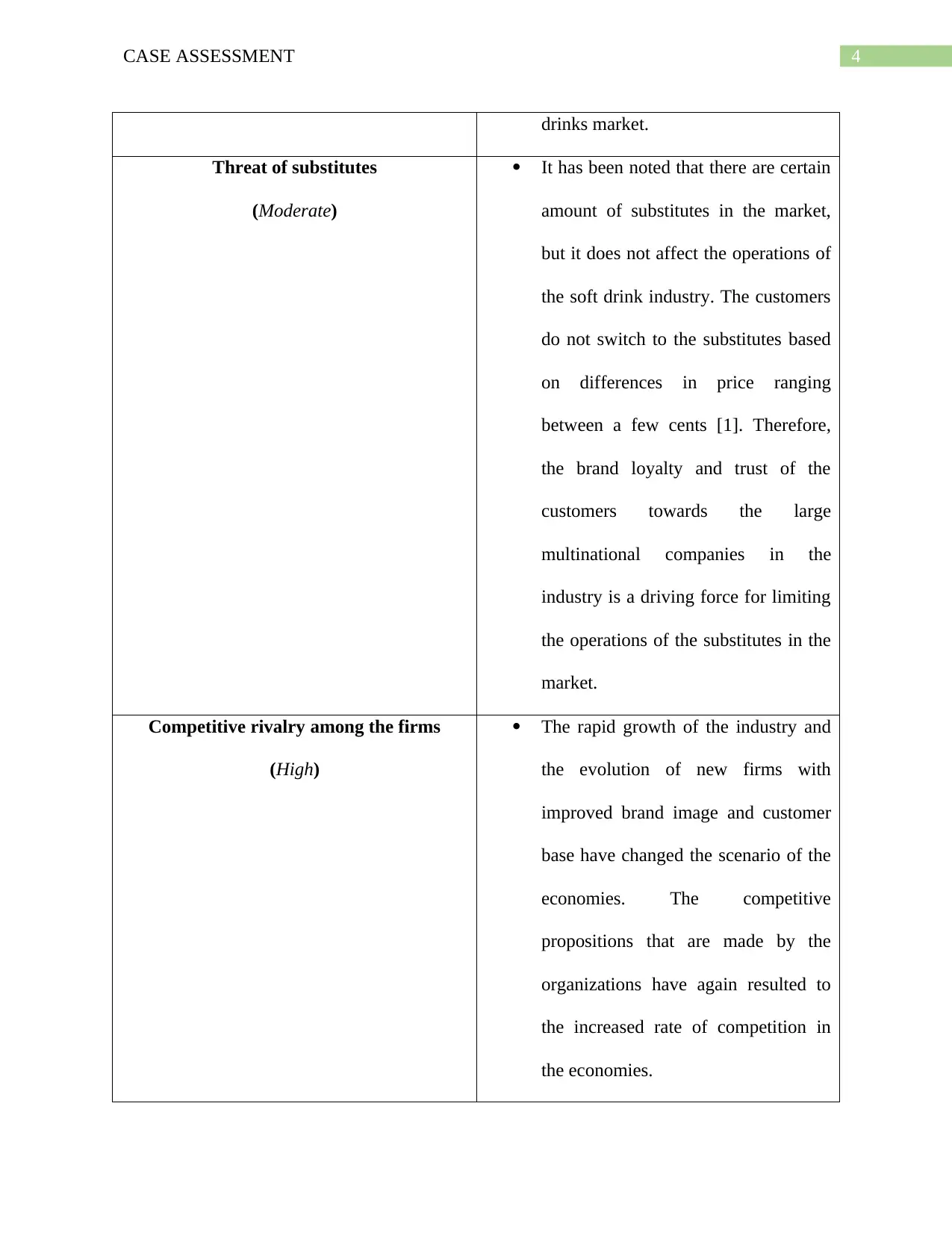
4CASE ASSESSMENT
drinks market.
Threat of substitutes
(Moderate)
It has been noted that there are certain
amount of substitutes in the market,
but it does not affect the operations of
the soft drink industry. The customers
do not switch to the substitutes based
on differences in price ranging
between a few cents [1]. Therefore,
the brand loyalty and trust of the
customers towards the large
multinational companies in the
industry is a driving force for limiting
the operations of the substitutes in the
market.
Competitive rivalry among the firms
(High)
The rapid growth of the industry and
the evolution of new firms with
improved brand image and customer
base have changed the scenario of the
economies. The competitive
propositions that are made by the
organizations have again resulted to
the increased rate of competition in
the economies.
drinks market.
Threat of substitutes
(Moderate)
It has been noted that there are certain
amount of substitutes in the market,
but it does not affect the operations of
the soft drink industry. The customers
do not switch to the substitutes based
on differences in price ranging
between a few cents [1]. Therefore,
the brand loyalty and trust of the
customers towards the large
multinational companies in the
industry is a driving force for limiting
the operations of the substitutes in the
market.
Competitive rivalry among the firms
(High)
The rapid growth of the industry and
the evolution of new firms with
improved brand image and customer
base have changed the scenario of the
economies. The competitive
propositions that are made by the
organizations have again resulted to
the increased rate of competition in
the economies.
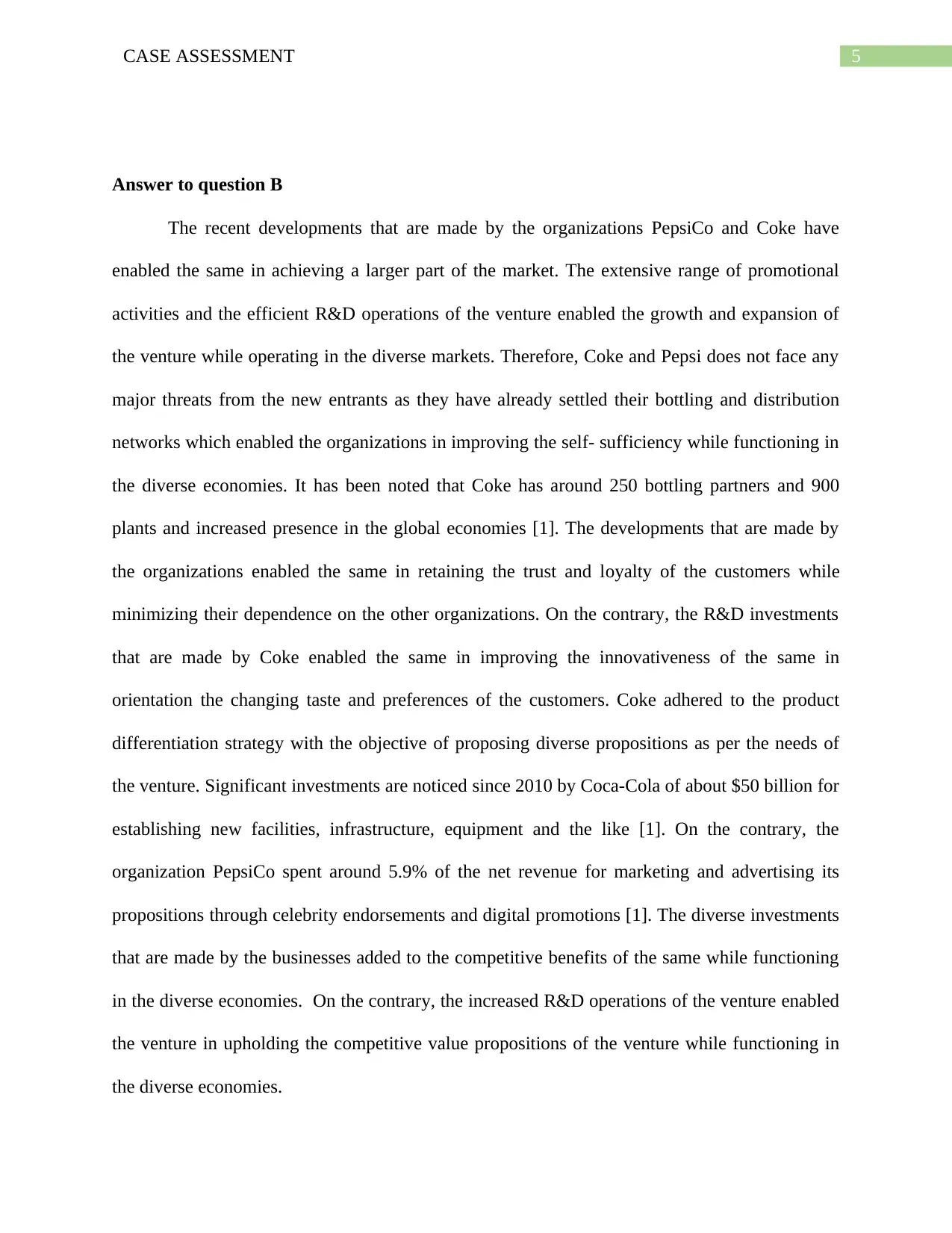
5CASE ASSESSMENT
Answer to question B
The recent developments that are made by the organizations PepsiCo and Coke have
enabled the same in achieving a larger part of the market. The extensive range of promotional
activities and the efficient R&D operations of the venture enabled the growth and expansion of
the venture while operating in the diverse markets. Therefore, Coke and Pepsi does not face any
major threats from the new entrants as they have already settled their bottling and distribution
networks which enabled the organizations in improving the self- sufficiency while functioning in
the diverse economies. It has been noted that Coke has around 250 bottling partners and 900
plants and increased presence in the global economies [1]. The developments that are made by
the organizations enabled the same in retaining the trust and loyalty of the customers while
minimizing their dependence on the other organizations. On the contrary, the R&D investments
that are made by Coke enabled the same in improving the innovativeness of the same in
orientation the changing taste and preferences of the customers. Coke adhered to the product
differentiation strategy with the objective of proposing diverse propositions as per the needs of
the venture. Significant investments are noticed since 2010 by Coca-Cola of about $50 billion for
establishing new facilities, infrastructure, equipment and the like [1]. On the contrary, the
organization PepsiCo spent around 5.9% of the net revenue for marketing and advertising its
propositions through celebrity endorsements and digital promotions [1]. The diverse investments
that are made by the businesses added to the competitive benefits of the same while functioning
in the diverse economies. On the contrary, the increased R&D operations of the venture enabled
the venture in upholding the competitive value propositions of the venture while functioning in
the diverse economies.
Answer to question B
The recent developments that are made by the organizations PepsiCo and Coke have
enabled the same in achieving a larger part of the market. The extensive range of promotional
activities and the efficient R&D operations of the venture enabled the growth and expansion of
the venture while operating in the diverse markets. Therefore, Coke and Pepsi does not face any
major threats from the new entrants as they have already settled their bottling and distribution
networks which enabled the organizations in improving the self- sufficiency while functioning in
the diverse economies. It has been noted that Coke has around 250 bottling partners and 900
plants and increased presence in the global economies [1]. The developments that are made by
the organizations enabled the same in retaining the trust and loyalty of the customers while
minimizing their dependence on the other organizations. On the contrary, the R&D investments
that are made by Coke enabled the same in improving the innovativeness of the same in
orientation the changing taste and preferences of the customers. Coke adhered to the product
differentiation strategy with the objective of proposing diverse propositions as per the needs of
the venture. Significant investments are noticed since 2010 by Coca-Cola of about $50 billion for
establishing new facilities, infrastructure, equipment and the like [1]. On the contrary, the
organization PepsiCo spent around 5.9% of the net revenue for marketing and advertising its
propositions through celebrity endorsements and digital promotions [1]. The diverse investments
that are made by the businesses added to the competitive benefits of the same while functioning
in the diverse economies. On the contrary, the increased R&D operations of the venture enabled
the venture in upholding the competitive value propositions of the venture while functioning in
the diverse economies.
⊘ This is a preview!⊘
Do you want full access?
Subscribe today to unlock all pages.

Trusted by 1+ million students worldwide
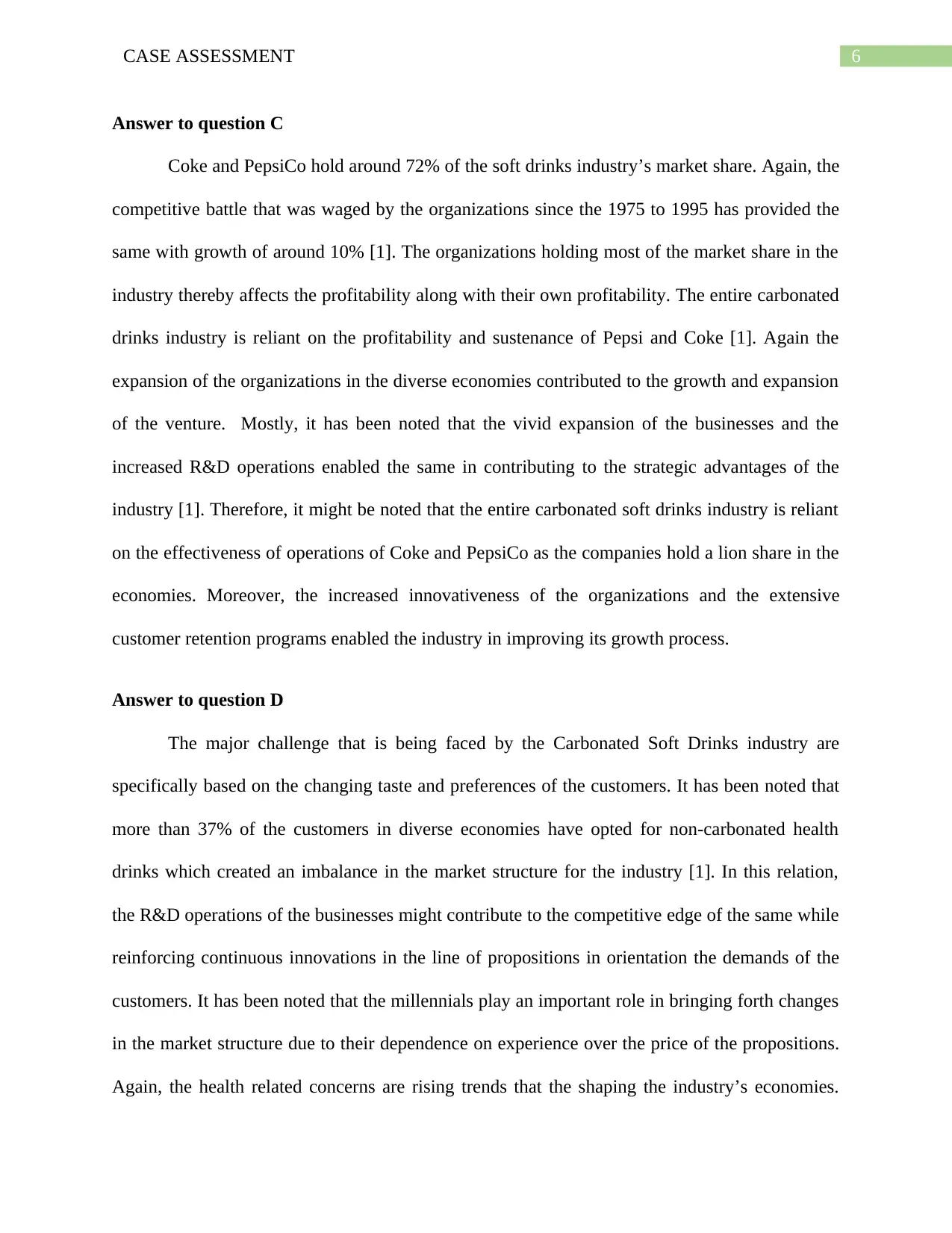
6CASE ASSESSMENT
Answer to question C
Coke and PepsiCo hold around 72% of the soft drinks industry’s market share. Again, the
competitive battle that was waged by the organizations since the 1975 to 1995 has provided the
same with growth of around 10% [1]. The organizations holding most of the market share in the
industry thereby affects the profitability along with their own profitability. The entire carbonated
drinks industry is reliant on the profitability and sustenance of Pepsi and Coke [1]. Again the
expansion of the organizations in the diverse economies contributed to the growth and expansion
of the venture. Mostly, it has been noted that the vivid expansion of the businesses and the
increased R&D operations enabled the same in contributing to the strategic advantages of the
industry [1]. Therefore, it might be noted that the entire carbonated soft drinks industry is reliant
on the effectiveness of operations of Coke and PepsiCo as the companies hold a lion share in the
economies. Moreover, the increased innovativeness of the organizations and the extensive
customer retention programs enabled the industry in improving its growth process.
Answer to question D
The major challenge that is being faced by the Carbonated Soft Drinks industry are
specifically based on the changing taste and preferences of the customers. It has been noted that
more than 37% of the customers in diverse economies have opted for non-carbonated health
drinks which created an imbalance in the market structure for the industry [1]. In this relation,
the R&D operations of the businesses might contribute to the competitive edge of the same while
reinforcing continuous innovations in the line of propositions in orientation the demands of the
customers. It has been noted that the millennials play an important role in bringing forth changes
in the market structure due to their dependence on experience over the price of the propositions.
Again, the health related concerns are rising trends that the shaping the industry’s economies.
Answer to question C
Coke and PepsiCo hold around 72% of the soft drinks industry’s market share. Again, the
competitive battle that was waged by the organizations since the 1975 to 1995 has provided the
same with growth of around 10% [1]. The organizations holding most of the market share in the
industry thereby affects the profitability along with their own profitability. The entire carbonated
drinks industry is reliant on the profitability and sustenance of Pepsi and Coke [1]. Again the
expansion of the organizations in the diverse economies contributed to the growth and expansion
of the venture. Mostly, it has been noted that the vivid expansion of the businesses and the
increased R&D operations enabled the same in contributing to the strategic advantages of the
industry [1]. Therefore, it might be noted that the entire carbonated soft drinks industry is reliant
on the effectiveness of operations of Coke and PepsiCo as the companies hold a lion share in the
economies. Moreover, the increased innovativeness of the organizations and the extensive
customer retention programs enabled the industry in improving its growth process.
Answer to question D
The major challenge that is being faced by the Carbonated Soft Drinks industry are
specifically based on the changing taste and preferences of the customers. It has been noted that
more than 37% of the customers in diverse economies have opted for non-carbonated health
drinks which created an imbalance in the market structure for the industry [1]. In this relation,
the R&D operations of the businesses might contribute to the competitive edge of the same while
reinforcing continuous innovations in the line of propositions in orientation the demands of the
customers. It has been noted that the millennials play an important role in bringing forth changes
in the market structure due to their dependence on experience over the price of the propositions.
Again, the health related concerns are rising trends that the shaping the industry’s economies.
Paraphrase This Document
Need a fresh take? Get an instant paraphrase of this document with our AI Paraphraser
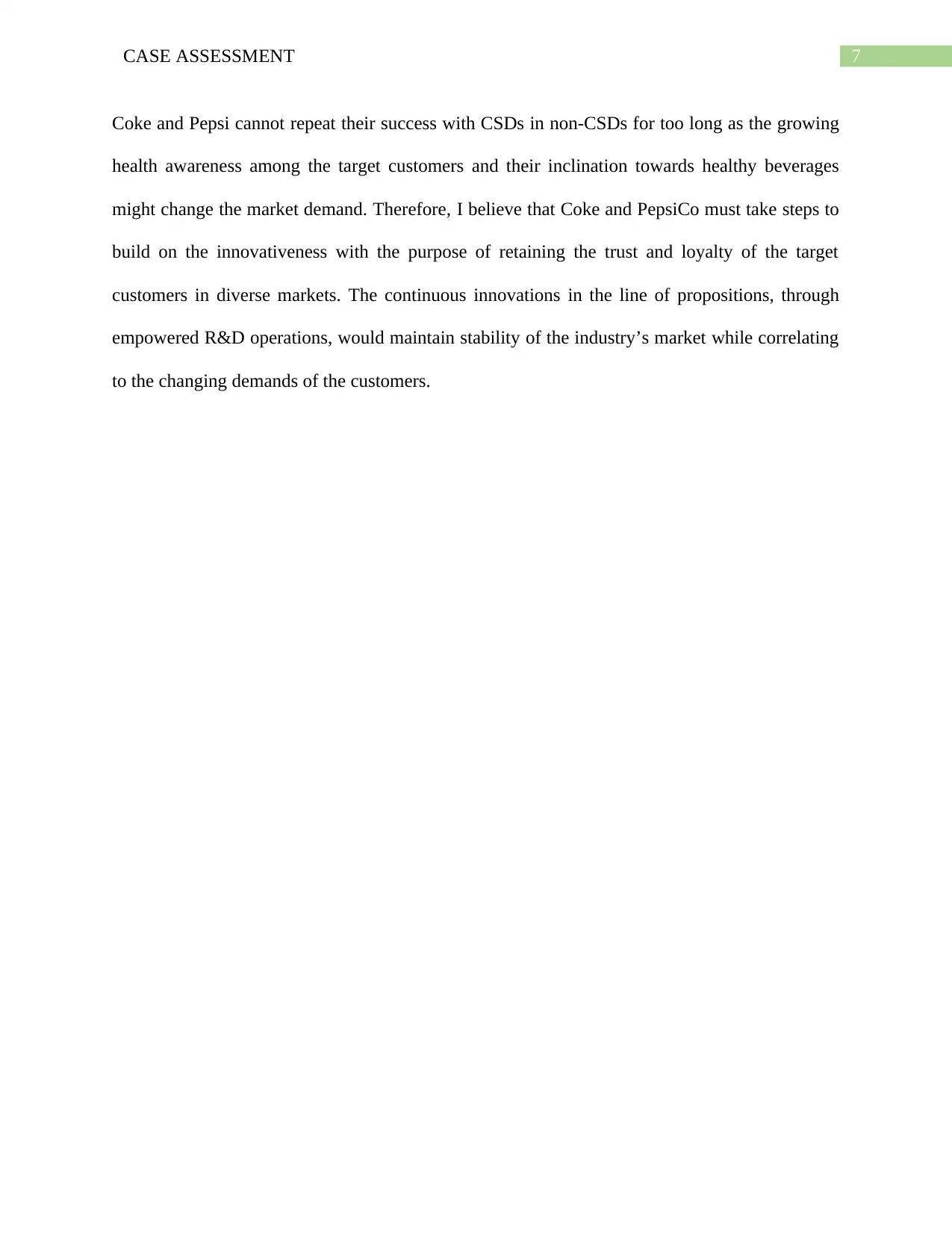
7CASE ASSESSMENT
Coke and Pepsi cannot repeat their success with CSDs in non-CSDs for too long as the growing
health awareness among the target customers and their inclination towards healthy beverages
might change the market demand. Therefore, I believe that Coke and PepsiCo must take steps to
build on the innovativeness with the purpose of retaining the trust and loyalty of the target
customers in diverse markets. The continuous innovations in the line of propositions, through
empowered R&D operations, would maintain stability of the industry’s market while correlating
to the changing demands of the customers.
Coke and Pepsi cannot repeat their success with CSDs in non-CSDs for too long as the growing
health awareness among the target customers and their inclination towards healthy beverages
might change the market demand. Therefore, I believe that Coke and PepsiCo must take steps to
build on the innovativeness with the purpose of retaining the trust and loyalty of the target
customers in diverse markets. The continuous innovations in the line of propositions, through
empowered R&D operations, would maintain stability of the industry’s market while correlating
to the changing demands of the customers.
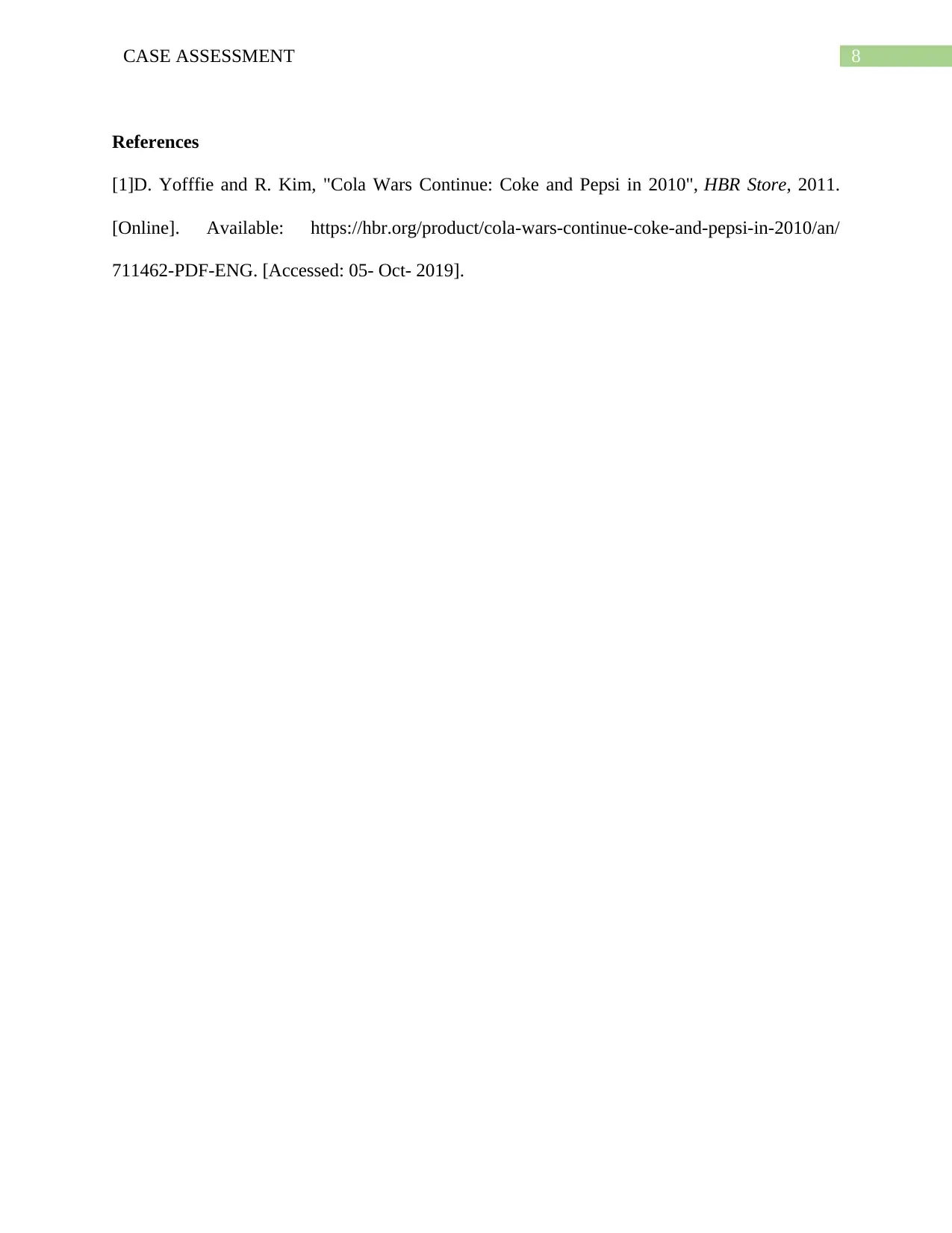
8CASE ASSESSMENT
References
[1]D. Yofffie and R. Kim, "Cola Wars Continue: Coke and Pepsi in 2010", HBR Store, 2011.
[Online]. Available: https://hbr.org/product/cola-wars-continue-coke-and-pepsi-in-2010/an/
711462-PDF-ENG. [Accessed: 05- Oct- 2019].
References
[1]D. Yofffie and R. Kim, "Cola Wars Continue: Coke and Pepsi in 2010", HBR Store, 2011.
[Online]. Available: https://hbr.org/product/cola-wars-continue-coke-and-pepsi-in-2010/an/
711462-PDF-ENG. [Accessed: 05- Oct- 2019].
⊘ This is a preview!⊘
Do you want full access?
Subscribe today to unlock all pages.

Trusted by 1+ million students worldwide
1 out of 9
Related Documents
Your All-in-One AI-Powered Toolkit for Academic Success.
+13062052269
info@desklib.com
Available 24*7 on WhatsApp / Email
![[object Object]](/_next/static/media/star-bottom.7253800d.svg)
Unlock your academic potential
Copyright © 2020–2025 A2Z Services. All Rights Reserved. Developed and managed by ZUCOL.



